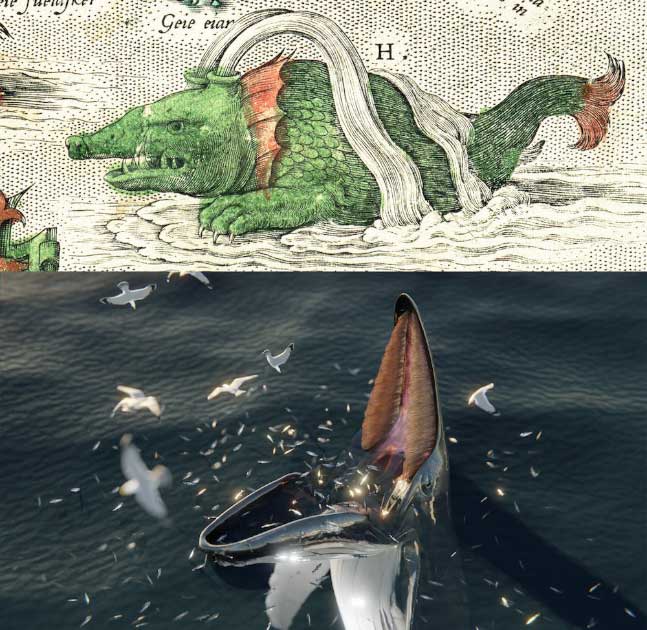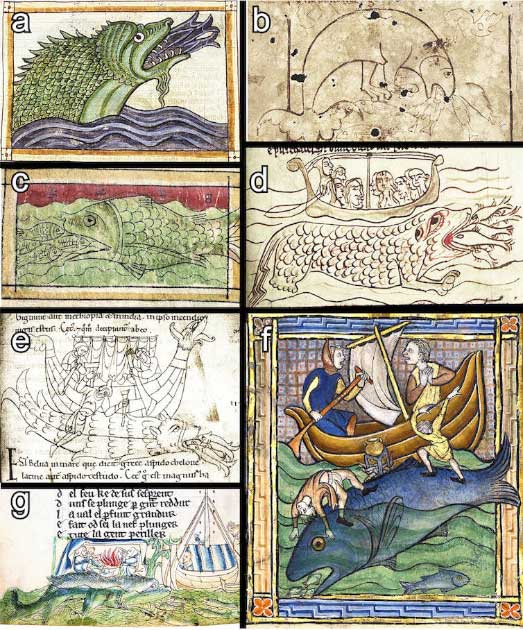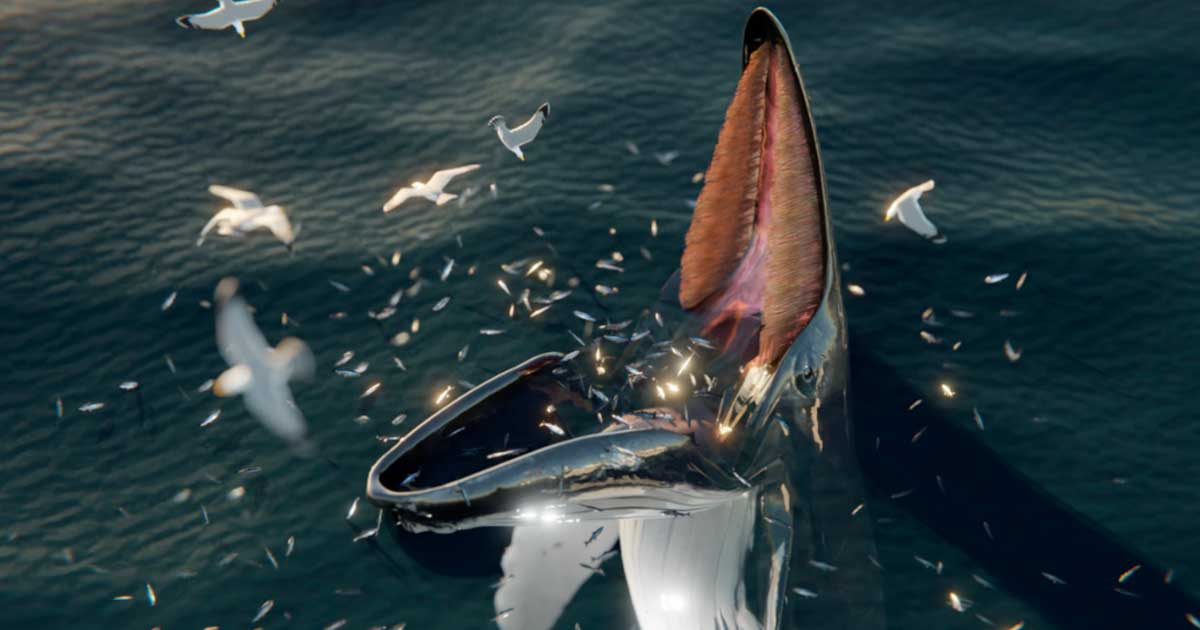Medieval Sea Monster Was Likely a Whale, New Research Reveals
A team of Australian researchers has come up with an intriguing theory about a gigantic sea creature referenced in 13th century Norse manuscripts. Known as the Hafgufa in Norway, this huge sea monster has long been associated with a mythological monster known as the Kraken, and it was therefore dismissed as legend despite the testimony of medieval fishermen and sailors who’d claimed to have seen it. But the Australian researchers have dismissed this dismissal, claiming that what people were actually seeing was a large whale, which was using a unique hunting strategy that allowed it to capture and consume whole schools of fish at one time, making it look like an insatiable sea monster.
The idea that the Hafgufa might be based on a real creature is not new. In the past the most common conclusion was that a giant squid or octopus had been mistaken for a monster by superstitious Norwegian fishermen, who believed in the Kraken and were thus predisposed to identify mysteriously large sea creatures as horrible man-eating predators.
But according to marine archaeologist John McCarthy and medieval historians Erin Sebo and Matthew Firth from Flinders University in Adelaide, Australia, the Hafgufa was most likely a whale and not an octopus or squid.
- Ten Mythical Creatures in Ancient Folklore from Around the World
- The Evolution of Sea Monsters on Medieval Maps

McCarthy noted this sea monster from Ortelius’s 1658 map of Iceland is described as having similar behavior as the earlier Norse accounts of a creature called the ‘hafgufa’ - could it be related to a recently observed feeding strategy of whales? Top: Detail from Ortelius's 1658 map of Iceland - 'H: the greatest of whales which could not chase fish but caught them through cunning. Bottom: digital representation of a trap-feeding humpback. (J. McCarthy/The Conversation)
Finding the True Hafgufa: Separating Myth from Reality
As they explain in an article just published in Marine Mammal Science, the researchers base their fresh conclusion on the surprisingly recent discovery that large whales sometimes use a method of hunting called trap or tread-water feeding to fill their humungous stomachs.
It was only about a decade ago that marine scientists observed humpback whales and Bryde’s whales floating in the sea with their mouths wide open, creating an illusion of a cave or shelter that could fool fish swimming near the surface of the water. Thinking they’ve found safe refuge, whole shoals or schools of fish would swim right into these whales’ mouths, never realizing they were swimming into a trap.
The similarity between this type of feeding and the behavior attributed to the Hafgufa was clear, study lead author John McCarthy said.
"I was reading some Norse mythology and noticed this creature, which resembled the viral whale feeding behavior,” he told Live Science. "Once we started to investigate a bit further, we noticed the parallel was really quite striking."
A detailed description of the Hafgufa and its behavior appeared in a 13th century Norwegian scientific text known as the "Konungs skuggsjá" or "King's Mirror," written by a naturalist in the service of the Norwegian King Hákon Hákonarson, who ruled his nation from 1217 to 1263. At around the same time, the creature was also referenced in the Örvar-Oddr, a 13th century Icelandic tale revolving around two sea monsters, the Hafgufa (sea mist) and the Lyngbakr (heather-back). Going back even further, a second-century AD Alexandrian text called "Physiologus" featured drawings of a whale-like creature, identified as an aspidochelone, which was filling up on fish that were leaping into its mouth willingly.
- Unmerciful Diets of Ancient Sea Monsters Of The Northern Abyss
- Mapping the Menacing Sea Monsters in Medieval and Renaissance Cartography

Various depictions of known or possible hafgufas/aspidochelones in 13th century medieval bestiaries from Europe. (Full details in Marine Mammal Science, 2023)
Given how often the Hafgufa was mentioned, the Australian researchers say, it seems likely that it did exist in some form and was not purely mythological. They are convinced that what medieval seafarers and chroniclers from different ages were describing was a type of whale that was deploying a trap or tread-water feeding strategy, eating on a scale that would have been truly awe-inspiring.
The medieval mariners would have understood that what they were seeing was a whale and not a monster, the researchers further assert.
"The tendency is to dismiss medieval accounts of the natural world as misinformed and inaccurate," McCarthy said. "In fact, although their framework of knowledge was quite different, they were able to give a precise description of this type of whale in the 13th century. It was later on, in the absence of being aware of this feeding phenomenon, that 18th century writers invented this sea creature and made these errors."
In other words, the similarities between the Hafgufa supposedly seen by sailors and fishermen and the mile-long Kraken of Scandinavian mythology are entirely coincidental, and the idea that they were one and the same was based on faulty reasoning.
In the Old Norse manuscripts, the Hafgufa is said to emit a powerful and enticing perfume that lures fish into its waiting mouth. The Australian researchers suggest this could be a reference to the odor of rotten cabbage that is often detected in the vicinity of feeding whales. They also note that Humpback and Bryde’s whales produce a distinctive smell when they regurgitate food, which helps them lure even more prey into their ravenous mouths.
Why the Elusive Hafgufa will Remain Elusive
So, are the Australian researchers right about the true identity of the legendary Hafgufa?
One potential flaw in their theory is the fact that trap feeding by whales has only been witnessed in the 21st century. Because these animals are so extraordinarily intelligent and adaptable, this hunting methodology may represent a new innovation that wasn’t practiced by whales living in medieval times.
In response to this, researcher John McCarthy points out that drone technology has now made it much easier to observe whales in action in the wild, and he suggests that maybe the increase in surveillance is the reason why trap-style feeding has finally been noticed.
There is no way to prove beyond a shadow of a doubt that the Hafgufa was a giant whale that once prowled the ocean waters around Scandinavia. At this point the alternatives to the mythological explanation are only theoretical, which means we’ll always be left to wonder just exactly what those medieval Norwegian sailors and fishermen were seeing when they claimed to have encountered a giant sea creature with a bottomless appetite for fish.
Top image: Digital representation of a trap-feeding humpback, thought to be the phenomenon explaining Hafgufa and other sea monsters. Source: J. McCarthy/Marine Mammal Science
By Nathan Falde




















Comments
It seems plausible. The Norse lived in nature and were well-versed in the sea. This would have given insights that the urbanised today would likely struggle to understand.
Much is lost in translation and not just from one language to another. Language is probably less of a hurdle than the gap between the understanding of the natural world through close encounters in daily life and an understanding derived from wildlife tv programmes, occasional bushwalks and maybe a safari trip or a visit to a zoo.
By contrast to the old ways, the modern urbanised know so much and yet so very, very little.